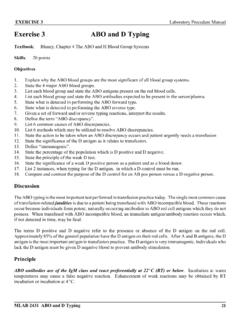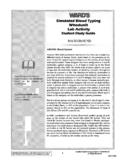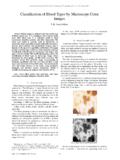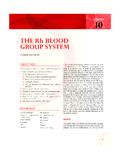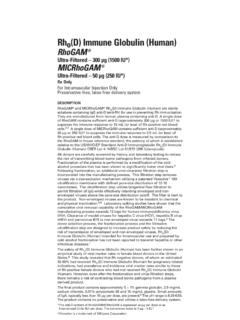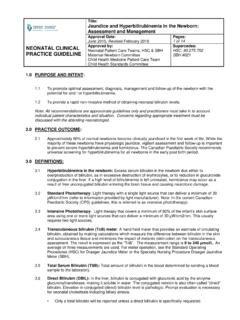Transcription of Blood Transfusions - - RN.org®
1 Blood Transfusions Reviewed September 2017, Expires September 2019 Provider Information and Specifics available on our Website Unauthorized Distribution Prohibited 2017 , , , LLC By Wanda Lockwood, RN, BA, MA Purpose The purpose of this course is to explain types of Blood donations, types of Blood components used for Transfusions , the procedure for Transfusions , and adverse reactions. Goals Upon completion of this course, the health professional should be able to: Give a brief description of the history of Blood Transfusions .
2 Describe the criteria for eligibility for donating Blood . Describe 4 types of donations. Explain ABO and Rh Blood typing. List at least 8 infective agents for which donated Blood is tested. List and describe at least 8 types of Blood components. Explain the volume of a unit of whole Blood , packed red Blood cells, platelets, and fresh frozen plasma. Explain leukoreduction, irradiation, and apheresis, intraoperative Blood salvage, and hemodilution. Discuss procedures for administration of packed red Blood cells, platelets, and fresh frozen plasma.
3 Describe 11 types of transfusion reactions, including symptoms and treatment. Introduction Approximately million Americans need Blood Transfusions each year, including 1 out of every 7 people hospitalized, with most people on average requiring 3 units of whole Blood or red Blood cells. For much of early history, people were bled instead of transfused. The first transfusion was given in 1765 by Phillp Syng Physick in Baltimore. Other physicians also tried Transfusions , with mixed results because they didn t have knowledge of Blood typing.
4 As a result, survival was a matter of luck. The discovery of Blood types by Karl Landsteiner in 1901 and routine typing of Blood by 1907 changed the outlook for patients although Blood supply was often insufficient to meet needs. A major turning point in medicine came in 1939 when Dr. Charles Drew developed a method to separate plasma from red Blood cells and freeze them separately although Transfusions still posed the risk of infections. Since the 1960s, tests have been available to detect infection, such as hepatitis B and HIV, in the Blood supply, and new tests are developed as new pathogens emerge.
5 Blood donations N. Gervacio, US Navy An adequate Blood supply is critical to providing Transfusions to those in need. However, Blood donors are unpaid volunteers. Blood given in return for money cannot be used to transfuse people in the United States. About 43,000 people donate pint of Blood each day in response to Blood drives or requests for Blood . Donation requires completion of a questionnaire to establish the person meets the criteria for donation, a brief physical assessment, donation of Blood , and then a snack. Standard donations usually involve removal of about 450 mL of Blood and take approximately 15 minutes.
6 The donor remains recumbent for a few minutes and then is given fluids and a snack and observed for about 15 minutes. A pressure dressing should be left in place for several hours and the donor advised to avoid heavy lifting. The donor should not smoke for an hour or drink alcoholic beverages for 3 hours. Apheresis is a process in which Blood is removed from a patient or donor, passed through a centrifuge or filter to remove components, and then the remaining Blood is returned to the person. The system is closed so there is little risk of bacterial contamination.
7 Donors may provide apheresis donations instead of donating whole Blood in order to provide larger quantities of Blood components, such as platelets, than can normally be provided from a single donor. The procedure takes about 2 hours. Donors may be given medication to take in the days before the procedure to increase production of certain Blood cells. Apheresis is also used to obtain stem cells from peripheral Blood for peripheral Blood stem cell transplant (PBSCT). For example, if platelets are needed, apheresis is carried out and the platelets separated from the Blood and saved.
8 An apheresis collection of platelets contains approximately 200 to 400 mL of plasma. To reduce the chance of ABO antibodies, the unit is volume reduced (concentrated). When platelets are collected from a number of different donors, these units are referred to as random apheresis platelets. Donations by family or friends for a specific person are directed donations. Some people feel safer getting Blood and Blood components from people they know although there is no evidence that directed donations are safer than random donations. Additionally, in emergency situations, obtaining and testing the Blood may delay treatment.
9 Sometimes patients donate their own Blood prior to elective surgeries, especially when Apheresis donors Directed donation Standard donation Autologous donation the potential for Blood loss is high, such as in orthopedic surgery. Usually, donations are made 4 to 6 weeks preoperatively and iron supplements or erythropoietin may be given to stimulate Blood cell production. People with rare Blood types may store Blood in case of emergency. While autologous donations can be frozen and stored for extended periods, the reality is that hospitals and Blood banks do not have facilities to save large quantities of Blood , so autologous donations are routinely discarded after surgery.
10 Once Blood is designated for a particular individual, it cannot then be used as a random donation for other people. Criteria for Blood donors Age 16-17 (depending on state). Weight 110 pounds Health Good Medications Most do not affect donation, but the donor must provide a complete list of recent and current medications and vaccinations as some may be contradicted and others (such as Accutane ) may require a waiting period after drug cessation. Diabetics who have ever used bovine insulin derived from cattle in the UK cannot donate. Interval Generally people can only donate 1 unit of whole Blood every 56 days.










